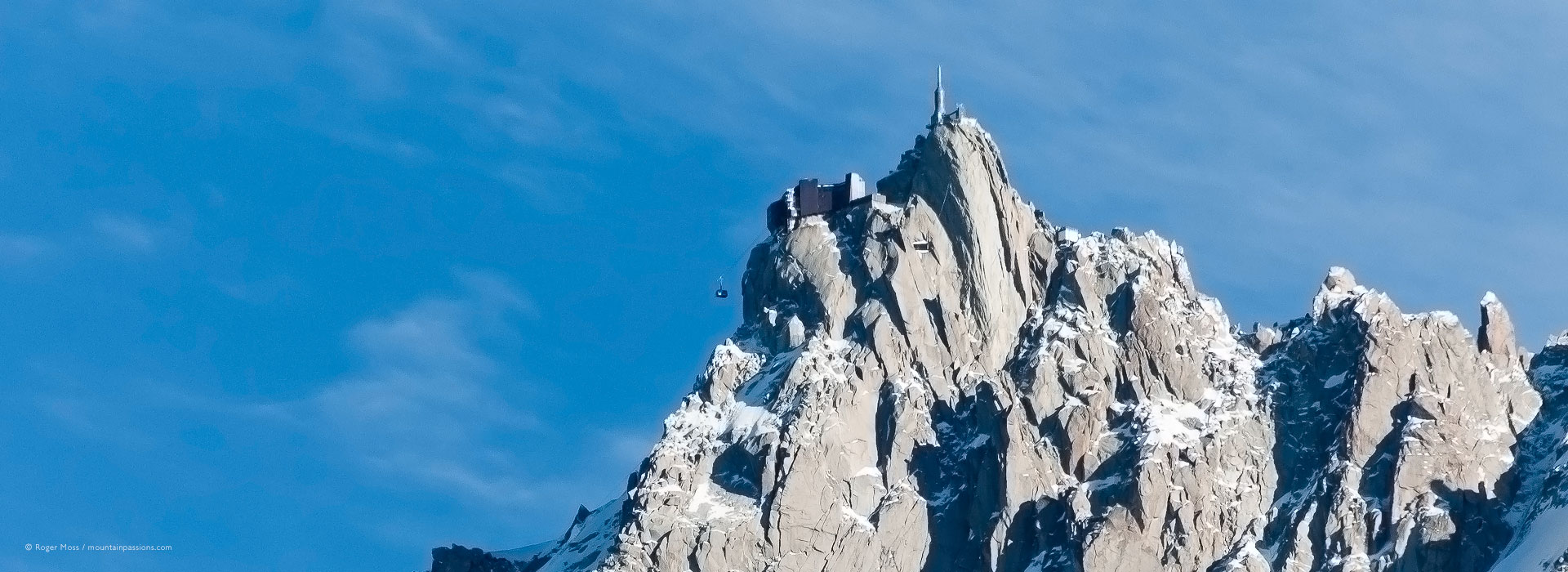
Ascent to the Aiguille du Midi
Chamonix Mont-Blanc
The unmistakable outline of the legendary Aiguille du Midi stand sentinel over virtually the entire Vallée de Chamonix. Topping off at a literally breathtaking 3842m, it’s both satisfyingly high and hypnotically remote-looking, but since the world’s greatest cable-car makes it accessible to anyone, who could resist?
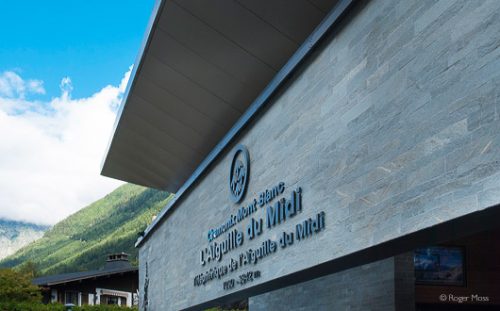
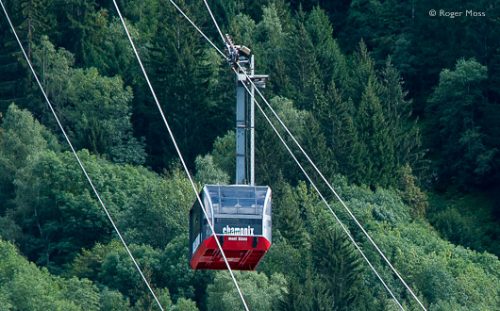
World’s greatest cable-car
Each year around 500 000 people respond to that particular temptation by riding the cable-car to find out for themselves just how everything looks and feels up there, a success story which is reflected in the newly-enlarged and extravagantly-restyled departure area. In fact, the whole complex is now on the kind of monumental scale which sends out a clear message that you’re in for the kind of experience you won’t forget in a hurry. From the off, the ride doesn’t disappoint, as the cable-car rolls off the end of the docking arms and onto the giant cables which droop under their own weight between the bottom station and the first steel pylon barely visible in the far distance up the mountainside.
After an initial surge of acceleration the cars settle into their operating velocity, for the lower section of what will be a two-stage haul, of around 10m/sec. Despite easing briefly to pass over the supporting pylons, the up-and-over passage creates a significant swinging sensation to entertain unsuspecting passengers. Otherwise, it’s a smooth haul, with little sense of speed until the descending car passes by at an impressive closing velocity of around 20m/sec.
Stage two: higher and (much) steeper
The upper section of the first stage flattens at the approach to the 2317m mid-station, at which point passengers transfer to the second car, for the truly epic haul all the way to the top. This time the operating speed is higher — 12.5m/sec — an increase which doesn’t seem overly significant until you’re passing the descending car, which is gone in a flash. Impressive.
It’s soon convincingly upstaged, however, as the final haul becomes ever nearer to vertical, and the car slows to an agonising crawl as it enters the perpetually ice-clad top station docking point. Suddenly the balmy summer vibe down in the valley seems a world away. Stepping from the arrival area means stepping into the dessicating chill of altitude (3777m) and onto a vertiginous bridge connecting with the central mass of the Aiguille’s topmost rocks. Fortunately, the surrounding scenery is enough to take your thoughts off the void below, including a first glimpse of Mont Blanc in all its snowy magnificence.
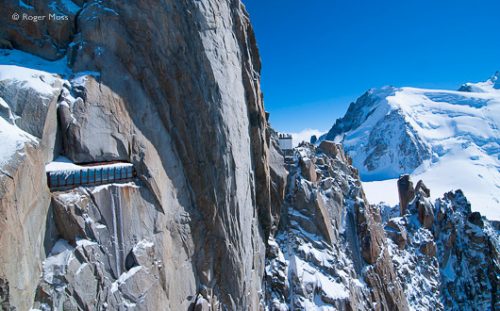
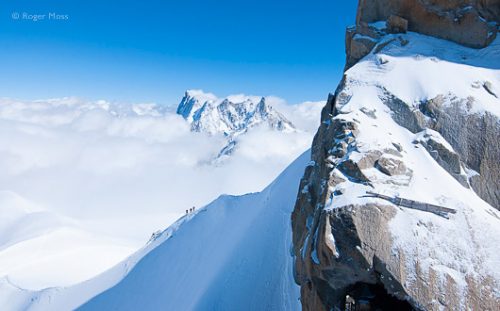
Gateway to the Vallée Blanche
Much closer at hand is something which will quicken the pulse of anyone with even the most basic grounding in Alpinism. The snow-covered Arête de l’Aiguille du Midi offers a testing rite of passage for skiers bound for off-piste terrain like Les Grandes Jorasses, the Glacier des Rognons and the world-famous Vallée Blanche — a 22km glacier itinerary (with almost 2000m of vertical drop) culminating at the Montenvers rail terminus.
Beyond the bridge, deep within the vast rocky spire of the Aiguille itself, lies a network of passages whose signage offers visitors directions to viewing terraces, a cafeteria, a restaurant plus the inevitable gift shop.
In the opposite direction, however, is a cave-like onward passage signed ‘Sortie Vallée Blanche’, which has an appropriately hardcore feel, climaxing in something resembling an ice-grotto and emerging onto a heart-stopping panorama across the famous arête. At this point the only thing lying between the unwary and a long, drawn-out plummet to the floor of the valley is a small iron gate with a sign proclaiming sternly ‘Access Interdite aux Pietons’. You have been warned.
In fact, there’s a steady flow of non-skiers taking this very route, but access to the high mountain at any time obviously requires special equipment (not least the crampons which even skiers are strongly advised to use) and the services of an experienced mountain guide. Close to the exit lies the departure point for another superlative experience, in the shape of the Panoramic du Mont-Blanc Italia. This pulsed gondola lift heads off across the Franco-Italian border to the Pointe (or Punta) Helbronner some 3462m above Courmayeur, in the Aosta Valley.
Mont Blanc
The high mountain is a testing environment, and over the years countless people have succumbed to the challenges, which has resulted in the creation of a series of celebrated high altitude refuges offering shelter, refreshment and basic overnight accommodation, not least to those for whom a pre-dawn start is a prerequisite to reaching the summit of Mont Blanc. Clearly visible from the southernmost viewpoints is the Refuge des Cosmiques (3613m), whose proximity to the Aiguille du Midi makes it a hugely popular on-mountain base. It huddles into the rocks reassuringly, but hidden from view is the kind of sheer drop which reminds you that nothing is ever quite what it seems in this kind of setting.
Beyond the refuge, and upstaging it into near-insignificance, is the unmistakable outline of the snowy giant known to the world as Mont-Blanc. Its sheer vastness is hard to take in,particularly the fact that the summit is almost 1000m higher than the Aiguille. At first glance it appears aloof and unassailable, but at most times, as your eyes adjust to the light levels it’s possible to make out the tracks of those who have trudged off to earn themselves a personal lifetime achievement by reaching the distant summit. But how distant, exactly? Well, the map informs you that the two peaks are roughly 23km apart, but in the mountains there’s never a direct route, and when you also allow for the lung-bursting climb involved you begin to get just an inkling of the kind of challenge involved.
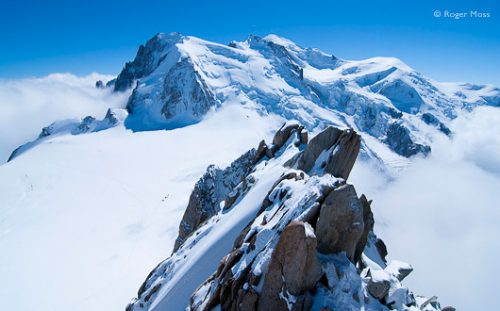
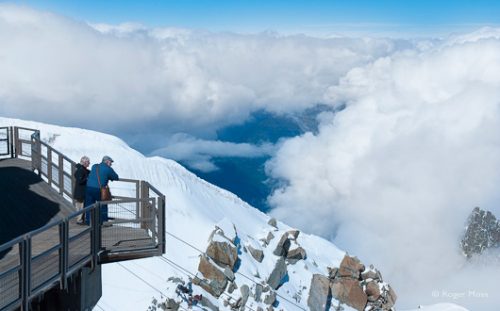
What they come for: the big views
There’s no shortage of fittingly breathtaking viewpoints. When things are particularly chilly you can take in some of the surrounding peaks from an indoor viewing gallery (l’Espace Mont-Blanc) — otherwise no fewer than six exterior ‘terrasses panoramics’ really get you in touch with it all, with what adds up to 360° coverage. However many pictures or video clips you might have seen, nothing can quite prepare you for the emotional impact of actually being up here on the roof of the world.
Accessible, but far from tamed
As for the Aiguille du Midi, those muscular cable-cars might have made it accessible to anyone with a ticket, but whatever your expectations, this extraordinary place will still take your breath away. By the time you’re heading back down to terra-firma, any ideas you might have once had as to the high mountains having been somehow tamed by their apparent accessibility will have been convincingly dispelled. These are still wild and potentially dangerous places, a fact which you might find as reassuring as we do. 
